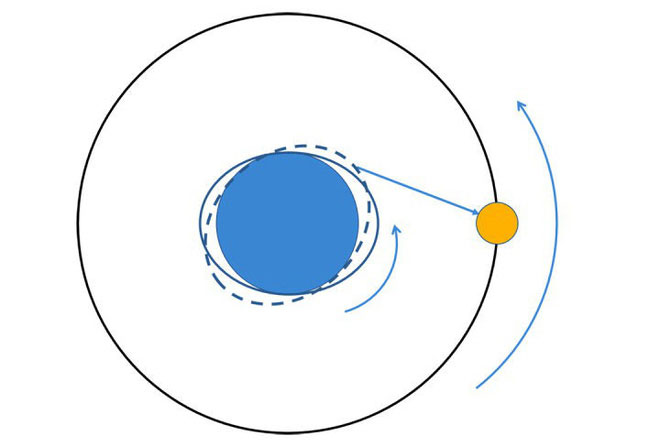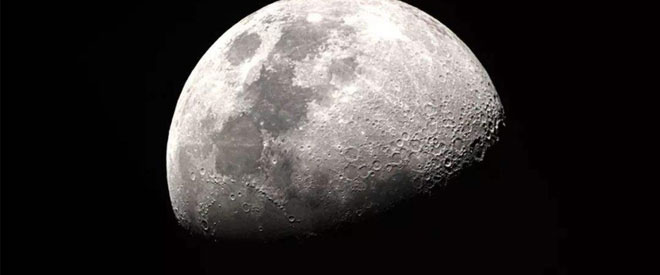How big was the moon in the dinosaur era?
Due to the influence of the tides in the Moon-Earth system, the dispersion of tidal energy causes the Moon's orbit to continue to decay, which means that the distance between the Moon and the Earth will be further away. than. Today, the average distance between the Earth and the Moon is about 384,400km. So, what is the distance between the Earth and the Moon in the dinosaur era? Does the moon look bigger now?
Due to the topographical characteristics of the Earth, different parts of the Earth will see the Moon at different rates so the gravity of the Moon will give the Earth a tidal effect. While the Earth itself is still rotating, raising the Earth's tide will be in the opposite direction of the rotation, slowing the Earth's rotation.

The moon orbits the Earth itself, but is locked tidal with our planet.
The moon orbits the Earth itself, but is locked tidal with our planet. Therefore, the orbit of the Moon coincides with its rotation, in addition to the angular momentum of the Moon-Earth system is always preserved, this phenomenon is the loss of energy of both planet.
In addition to slowing down the rotation of the Earth's axis, it also causes the Moon's orbit to expand.
It can be seen that in the last 1 billion years, the rate of lunar orbit decayed not much changed and the change of the Earth-Moon distance over time was basically linear. To facilitate the calculation, the scientists thought that the rate of decay orbit of the moon in the past is similar to the present in the past one billion years, which is about 3.82 cm / year.
Dinosaurs first appeared about 240 million years ago. At the time, the average distance between the Earth and the Moon was about 375,200 km, closer than today to 9,200 km.

During the time of the dinosaurs, the Moon was closer to Earth than it is now.
It can be seen that this distance change is not very large, the average apparent diameter of the moon 240 million years ago was 0.531 degrees and now the average apparent diameter of the moon today is about 0.518 degrees.
Therefore, the area of the Moon seen from Earth 240 million years ago was only 5% larger than it is today, and this change in proportion would not be detected by the naked eye.
According to calculations, when newly formed, the distance between the Moon and the Earth is just over 20,000 km.
While the moon is moving away from Earth, the period of rotation around the axis of the third planet in the solar system is gradually increasing. Earth currently orbits the axis in about 24 hours, in the dinosaur era 21 hours and only 4 hours in the early days of Earth.
According to calculations, with the speed away from the Earth's Moon in the past 10,000 years, the Moon has traveled 380m away from Earth.
That would take another 5 billion years for the Moon to travel 200,000 km. Even so, the Moon will still be in Earth's orbit with a different cycle than it is now.
Another 5 billion years is also the time when the Sun enters the stage of bulging the crust and becoming a red giant so big that it crushes Venus, Mercury and both the Earth and the Moon.
It is a long time compared to a human life so we do not need to worry about this.
- Shocking discovery of dinosaurs drive and
- Scientists recreate dinosaur embryos from chicken DNA
- Detecting the nocturnal egg nest of the dinosaur fetus
- Suddenly appeared a giant
- Close up of the world's largest dinosaur park
- Does the Moon have its own moon? And you will be surprised with its name!
- Series of dinosaur footprints revealed after storm in England
- Clean-falling dinosaur teeth when grown up
- Find the 'super small' skull of the giant herbivorous dinosaur
- 110 million year old dinosaur fossils
- Dinosaur park is only in imagination
- Can the gender of dinosaur fossils be determined?
 'Fine laughs' - Scary and painful torture in ancient times
'Fine laughs' - Scary and painful torture in ancient times The sequence of numbers 142857 of the Egyptian pyramids is known as the strangest number in the world - Why?
The sequence of numbers 142857 of the Egyptian pyramids is known as the strangest number in the world - Why? History of the iron
History of the iron What is alum?
What is alum?